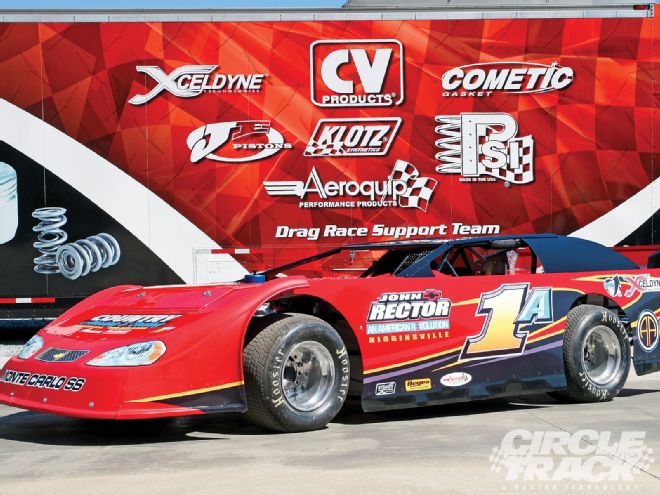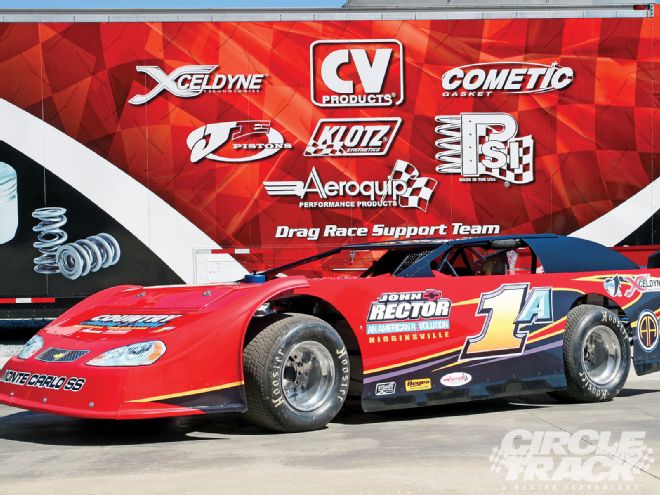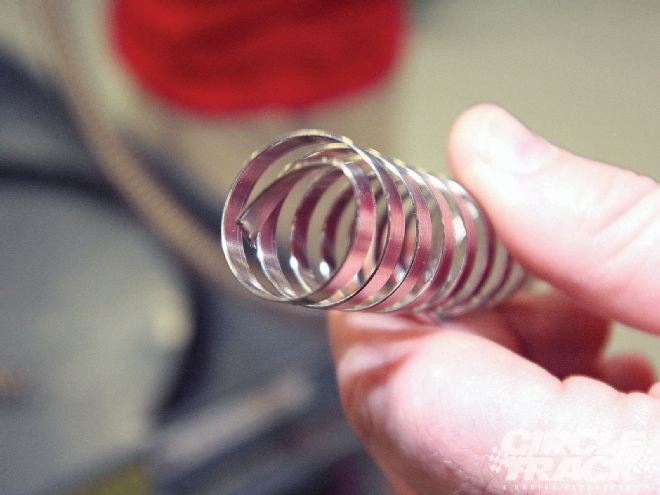
Weight is the racer's bane. Every racer wants to cut weight, either simply to make his car lighter, or-if there is a minimum weight rule-so that he has more lead available to move around and improve the overall weight bias. But it's not always quite so easy.
 If you could cut as much as 45 percent off of one component on your race car, would you do it? That's exactly what we did with this DLM Shaw by Perky chassis by using Aeroquip's arLite hoses instead of standard steel-braided hoses.
If you could cut as much as 45 percent off of one component on your race car, would you do it? That's exactly what we did with this DLM Shaw by Perky chassis by using Aeroquip's arLite hoses instead of standard steel-braided hoses.
Racing is a rough business, and often components have to be beefy in order to stand up to the punishment they are exposed to weekly. If you cut too much weight with suspension or chassis components, you may just wind up on the trailer early with a DNF. The same thing goes for engine components.
You can go with high-tech materials that maintain strength, but the downside here is they can often be exorbitantly expensive. Plus, if you go the high-technology route, even if it's legal now, as soon as it becomes more popular there's always the chance your racetrack will make it illegal in order to keep costs contained.
One great option that is legal in almost all racing series, is just as durable as its heavier-weight counterpart, is still affordable (although a bit more expensive than standard equipment) and, most importantly, can cut a significant chunk of weight off your car is lightweight hoses.
To find out more we stopped by the shops of CV Products in Thomasville, North Carolina, while CV's Andy Durham installed practically all the plumbing on a new Dirt Late Model for driver Bryon Allison.
Durham chose Aeroquip's StarLite line of lightweight hoses and fittings for the job for both durability and ease of use. Aeroquip says its StarLite hoses are 45 percent lighter than standard stainless steel braided lines, which really adds up when you consider all the fluid that must be moved throughout a race car. On a typical race car this usually equals cutting 15 pounds off the total weight of the car.
Aeroquip's StarLite hose is also a good choice for most racing applications because it is available in AN sizes 4 through 20, has a cover woven from Nomex and Kevlar that is not only flame resistant but also offers good wear resistance, can handle fluids up to 300 degrees F, is quite flexible to make routing easier, and can be used with a support coil so it can also be used in suction lines.
 It's nearly impossible to simply cram the inner liner into the hose. Instead, there's an easier way. Begin by bending the end of the coil.
It's nearly impossible to simply cram the inner liner into the hose. Instead, there's an easier way. Begin by bending the end of the coil.
Possibly the best part is the installation of all the lines in the car was done in a single morning's worth of work (although it did require a late lunch). To get the lightest possible package, a race team will want to use the lightweight aluminum crimp fittings, but that requires a special hydraulic crimping tool which runs for approximately three grand. If you check around, however, lots of race shops have the tool.
CV Products, which does a lot of lightweight hose packages for race teams all over the country, says the most common method is for racers to send their old hoses off their car and CV's technicians can duplicate them-including hose size, length, and end styles-in lightweight hoses and send them back.
Or if you don't want to, or can't, ship your old hoses, you have other options. Obviously, you can send in a written list of the hoses you want. Just be sure to be very specific about the AN size of each hose, the length, and what type of ends you want (specifically the angle of the bend, if any). Another option, especially with a brand-new chassis that has never been plumbed before, is to use pieces of string, welding wire, or anything else you have handy to lay out the route of your hoses. Many people find this is a lot simpler than trying to figure out total length, including bends, with a tape measure. Then take those pieces and use a piece of tape to label each end with exactly what type of hose end you want. Also, don't forget to label each piece whether it is a pressure hose or vacuum because the vacuum hoses will require an inner support coil to prevent their collapsing.
Once you've got that done, box it all up and ship it to CV for it to create your plumbing package. All that will be left for you to do is hook everything up.